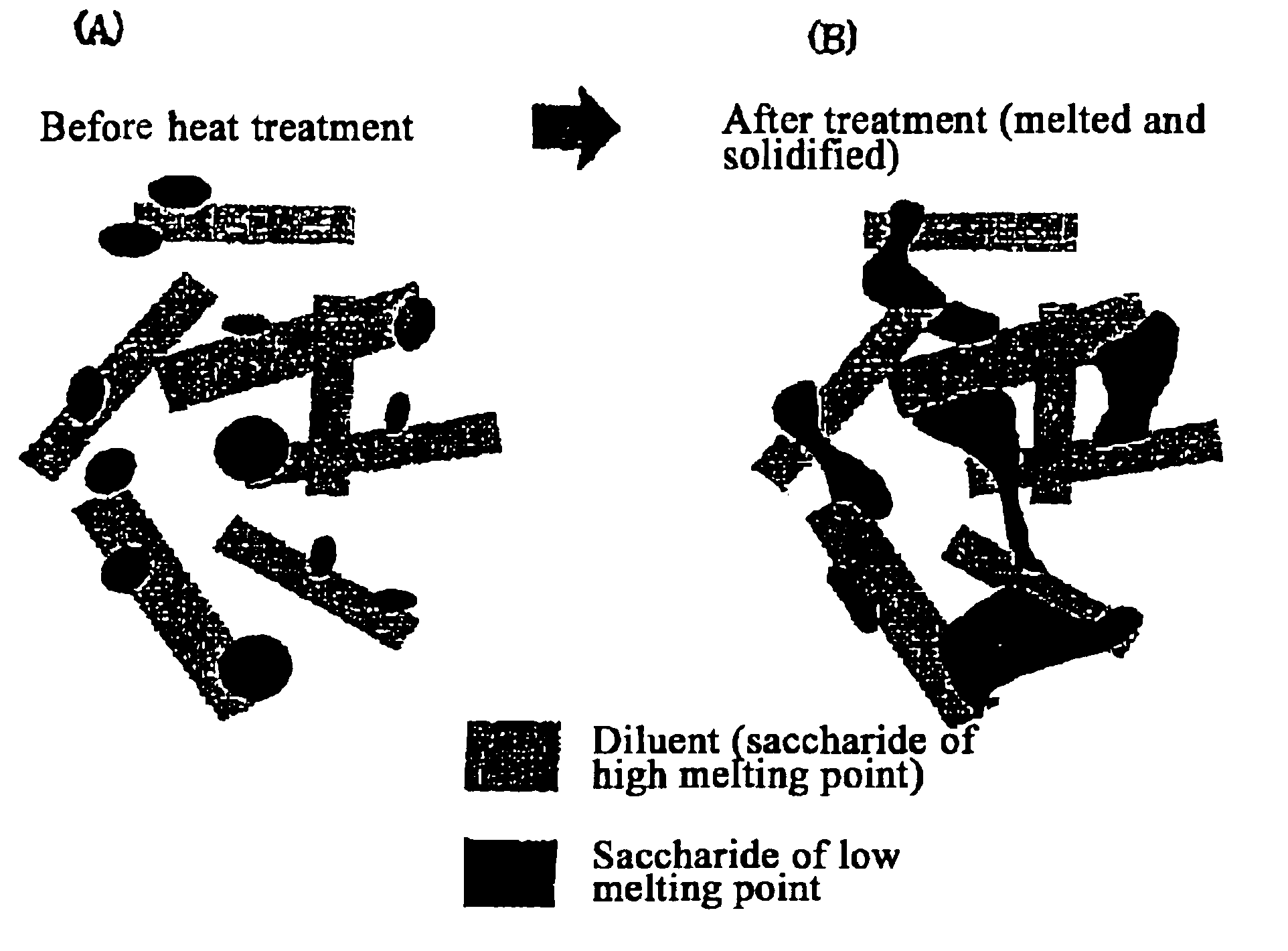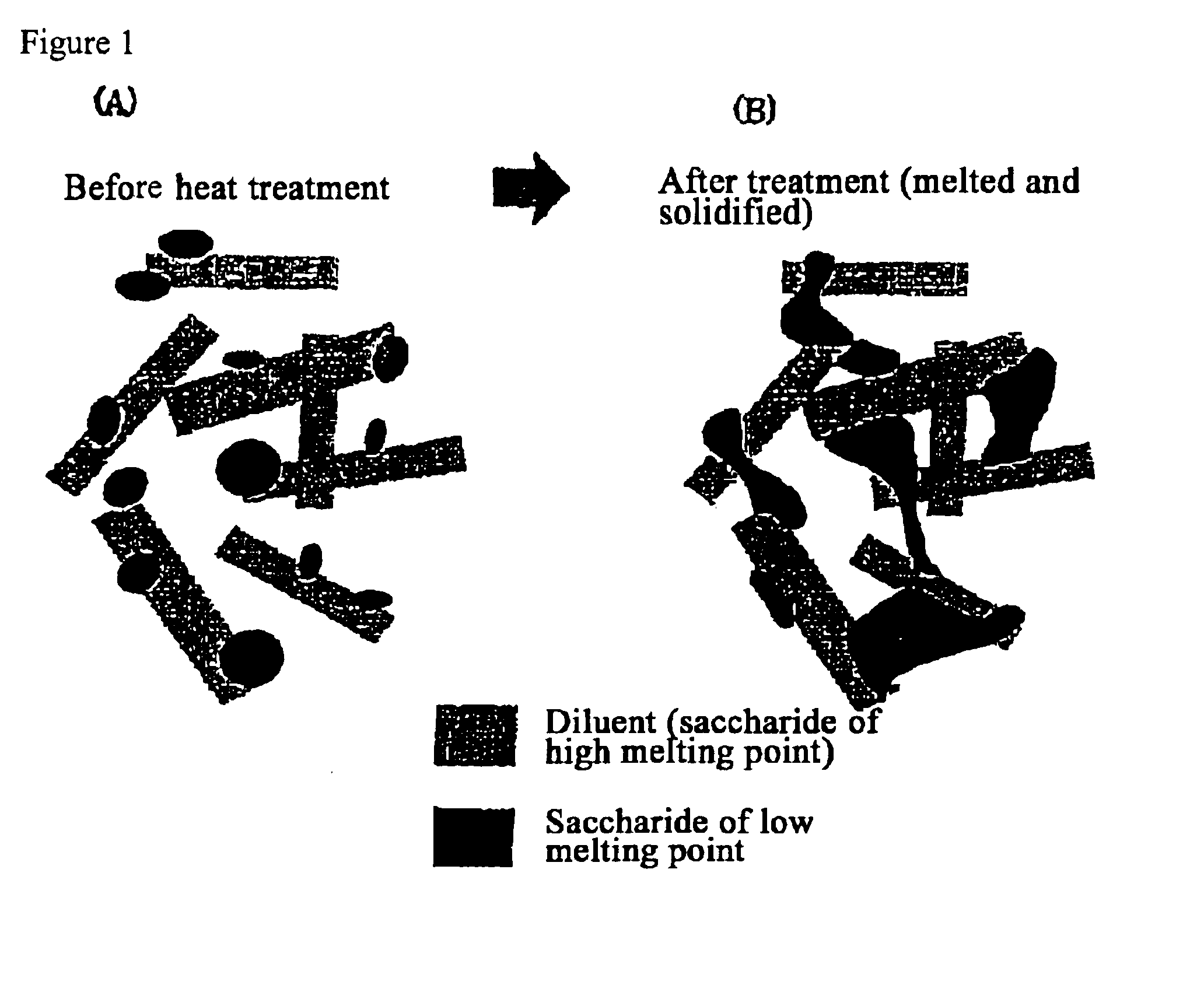Quick-disintegrating tablet in buccal cavity and manufacturing method thereof
a technology of rapid dissolution and buccal cavity, which is applied in the field of quick dissolution tablet can solve the problems of no disclosure or indication of a specific means, delayed dissolution in the buccal cavity, and tendency toward, and achieve the effect of retaining the ability to quickly disintegrate and maintaining a porous structur
- Summary
- Abstract
- Description
- Claims
- Application Information
AI Technical Summary
Benefits of technology
Problems solved by technology
Method used
Image
Examples
experiment 1
Confirmation of Melting by Heating of Saccharide and Changes in its Crystal Form
(Method)
After thoroughly crushing trehalose (Hayashibara Co., Ltd.), maltose (brand name Sunmalt-S, Hayashibara Co., Ltd), sorbitol, sucrose, mannitol (Towa kasei Co., Ltd.), erythritol (Hayashibara Co., Ltd.), xylitol (Towa Kasei Co., Ltd) as the saccharides with a mortar and punch, they were transferred to a glass dish and heat treated for 5 minutes at 140° C. using a program oven (model No. MOV-112P, Sanyo).
Melting of the saccharide was visually confirmed. After cooling the molten saccharide to room temperature, it was crushed again using a mortar and punch and determinations were performed with a differential scanning calorimeter (DSC hereafter) and crystal form was evaluated.
The maltose was further humidified over night under conditions of 25° C. and 75% RH using a thermostatic vessel at constant humidity (Tabaiespec Co., Ltd., PR-35C) and DSC determination was performed. A physical mixture of manni...
experiment 2
Tests Relating to Raising Hardness of Model Tablets (Mannitol / maltose)
(Method)
Model tablet A (tablet A hereafter) was prepared as follows: First, 450 g mannitol were sifted with a sieve (20 mesh) and then granulated using a fluid bed granulator with 250 g aqueous maltose solution (20 w / w %) as the binder. Then 0.5% w / w magnesium stearate was added to this granulation product and mixed, and tablets of approximately 200 mg per 1 tablet were made using a rotary tableting machine. Tableting pressure was adjusted as needed to obtain a tablet hardness of approximately 1 kp, and it was approximately 0.1 t / punch. Tablet A was heated and / or humidified as described below (group 1: heat-treated only, group 2: humidified after heat treatment, group 3: heat-treated after humidification, and humidified once again). The treatment conditions of each process were heat treatment for 5 minutes at 140° C. using a program oven (model MOV-112P, Sanyo), and humidification treatment involved humidification...
experiment 3
Tests Relating to a Rise in Hardness of Model Tablets (Mannitol / trehalose, Mannitol / erythritol)
(Method)
Model tablets B and C were prepared as follows: First, 450 g mannitol were sifted with a sieve (20 mesh) and then granulated using a fluid bed granulator with 250 g aqueous trehalose solution (model tablet B, tablet B hereafter) or aqueous erythritol solution (model tablet C, tablet C hereafter) (20 w / w %) as the binder. Then 0.5% w / w magnesium stearate was added to this granulation product and mixed, and tablets of approximately 200 mg per 1 tablet were made using a rotary tableting machine. Tableting pressure was adjusted as needed to obtain a tablet hardness of approximately 1 kp, and it was approximately 0.1 t / punch for tablet B and approximately 0.25 t / punch for tablet C. The model tablets were heated and / or humidified as described below (group 1: heat-treated only, group 2: humidified after heat treatment, group 3: humidified). The heat treatment conditions for tablet B were ...
PUM
| Property | Measurement | Unit |
|---|---|---|
| porosity | aaaaa | aaaaa |
| porosity | aaaaa | aaaaa |
| melting point | aaaaa | aaaaa |
Abstract
Description
Claims
Application Information
 Login to View More
Login to View More - R&D
- Intellectual Property
- Life Sciences
- Materials
- Tech Scout
- Unparalleled Data Quality
- Higher Quality Content
- 60% Fewer Hallucinations
Browse by: Latest US Patents, China's latest patents, Technical Efficacy Thesaurus, Application Domain, Technology Topic, Popular Technical Reports.
© 2025 PatSnap. All rights reserved.Legal|Privacy policy|Modern Slavery Act Transparency Statement|Sitemap|About US| Contact US: help@patsnap.com



